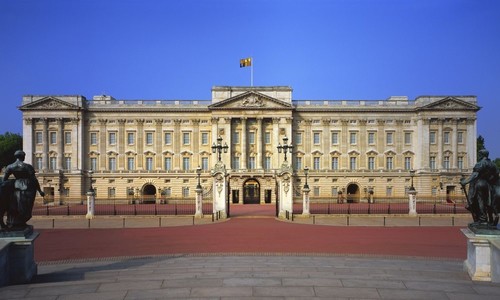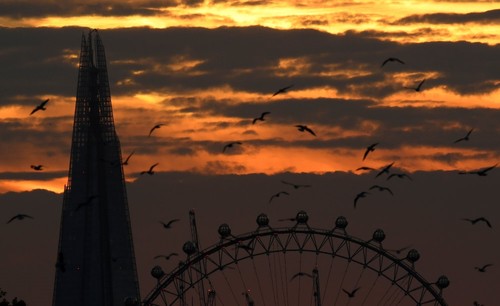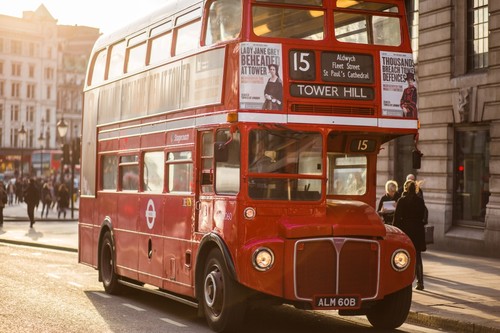© Turkuvaz Haberleşme ve Yayıncılık 2024
How is a city like London even possible? I know I'm the last travel writer on earth who hadn't been to London (before last week) but seriously, why didn't anyone tell me it's so good? It is a cartoon in primary colors, where two-story buses zoom around nice clean streets, where bright shop fronts hold place with cheery pubs, where there's two thousand years of debris that's been systematically labeled, cleared away, and posted up inside convenient viewing booths. They've got telephone booths! Umbrellas! Giant imperial iron lions! The Queen! Bookstores and the food of a thousand nations! Hypermodern architecture nicknamed after pickles! Both fish and chips! (I ate neither.)As it would be totally pointless to pretend that I've given the entire city any due in a 2,000-word piece, I'll give you a classic 48-hour crash course to see the sights without drowning in the Thames.

Day 1
We flew into Gatwick, and immediately I was impressed that everything works. It sounds stupid, but after months of travel in countries where I do not speak the language, it was just astounding to buy a travel card at a desk, fill it up with cash, and then know it would work on the train to London, on the Tube to the nearest station, and on the bus to our friend's flat. The name "oyster card" was chosen for the transit cards, because it had no relation to London or trains or transit of any kind. They wanted a fresh start. Great success.
First order of business was, oddly, voting. This is something you probably won't do on your trip to London, but I was staying with a pack of Kiwis, and the New Zealand general election is going on right now. The New Zealand High Commission is right next door to Trafalgar Square so while they all popped in to submit a ballot I examined a very long thumb. Trafalgar Square has always housed public art, and currently it's got a controversial sculpture of a thumbs-up (with a 7-meter-long thumb) called "Really Good." It is controversial because every other sculpture looks spectral with dignity, and there's a big dumb long thumb on a pedestal. I'm not sure I understand the controversy, since also in Trafalgar Square a variety of colorful street performers, none of whom are all that dignified, (Pikachu, floating genii, et al.) ply their trade. Or give out free hugs.
Next was Big Ben (under renovation). Then, Westminster Abbey (closed to the public for an event.) So fine: Buckingham Palace. The actual Queen of the actual United Kingdom. You can tell she's home because the flag's up, and because the queen signal has been activated. I wanted to do the traditional dingus tourist thing to do and wave my hand in front of the Royal Guards, as they're not permitted to respond or move unless you're really causing a ruckus. But of course they don't let regular people into the Palace! With the Guards! And the Queen! What was I thinking. Goodbye, men in fur hats.
Next was St. James Park to play with the ducks and the squirrels. The ducks mostly ignore whomever comes their way, but the squirrels are tame enough that if you hold out nuts, they will scurry up your leg and grab a macadamia right out of your hand. Everyone from tourists to businesspeople to church groups to classes were out in the park, taking in the rare sunlight and picnicking.

Lunch of course had to be Camden Market. Camden Market even someone as illiterate as me had heard of - one of the closest things London has to an Istanbul bazaar. Just beyond a wide shopping street where I could have bought any number of "My daughter/son/girlfriend/important relation went to London and all I got was this lousy T-shirt" T-shirts, which, by the way, did anyone realize they still made those, lies Camden Market. Most bazaars in the world are incoherent mazes; this being London, it was instead a charming collection of well-decorated street food vendors in a sensibly laid out courtyard bounded by a placid canal and a weeping willow. It was also packed, because the street food had innovated itself into brilliance. London's a wild combination of cultures, and they keep one-upping each other for food supremacy. Kimchi burritos, designer churros, and Bhangra B's Curry Lamb Burger were all on the menu. My friends and I grabbed our favorites and retired to a sunny terrace on the upper level of the market, and watched the pandemonium below. I sipped on strawberry-lime cider and snacked on tiny Dutch pancakes covered in Nutella.
After the terrace we spent some time investigating the market. A fat Caribbean woman selling sweatshirts gave us all a boisterous rendition of "Buffalo Soldier" as we walked past. We found an alleyway full of horse sculptures selling rugs. Inside a shop called Cyber Dog, they played very, very loud electronic music, and two girls on green balconies danced to show customers it was a hip place to shop for rave clothes while being completely unable to have a conversation.

In between exploration and dinner, we had a whole two hours to kill. We visited three different local pubs in Kensington, trying to find a place with an open table, and found The Uxbridge Arms, about as stuffy British as you can get - soft wood and carpet, a menu of meats and cheeses from local farms, a drink called DOOM BAR served from a golden pump. Oh, and it's a real spring chicken of a pub at only 200 years old. Some of the pubs in this country have been operating since before the Aztec empire collapsed.
We went back to Clapham Commons for a dinner of Flip n' Dip. The restaurant was jammed full of rowdy Saturday-night party seekers, but the food was serious business. A Flip n' Dip sandwich is a burger with cuts of roast beef, cheese, served with a pool of au jus. I will cry and dream of Flip n' Dip forever. I want to be buried with a Flip n' Dip, and I also want my body to be made into a Flip n' Dip, and then dipped. On a completely unrelated note, I have gained seven kilos. Seven kilos is called a stone in the U.K. talk, kids!
Day 2
We hauled ourselves out of the brief embrace of slumber to go to brunch at Caravan at King's Cross Station. It's what's called a "soft industrial" style of decor, all black metal and exposed brick in an open hall. They offer traditional English breakfasts with high-quality ingredients, and also the traditional hipster food of avocado on toast. I got roasted field mushrooms with poached eggs, tomatoes, thick-cut bacon, and sourdough bread. They also roast their own coffee out back. On the way out, we stopped by platform 9 and 3/4, where a huge line of Harry Potter enthusiasts were queued up to take a picture with a luggage trolley half-submerged as if by magic! into the brick wall.

But there's no time to dwell on breakfast when there's culture to be digested. We had to hit both the British Museum and the Tate Modern in a single bound. Fortunately, I get addled in museums quite quickly, so once I get a brief dose I feel free to escape. And, best of all, these museums are free. Again, why did nobody tell me London was so great?
The British Museum holds all the wonderful things the British Empire swiped from the rest of the world during that whole era when pillaging and pilfering was a bit more encouraged. I made a beeline for the Mesopotamia and Egyptian rooms. The Rosetta Stone was easy enough to find, since a gawking group had planted themselves in front of it to snap pics - it's famous because scholars used it to decode Hieroglyphics. Two other proclamations were carved beneath the Hieroglyphics, one in Greek and one in Demotic, which made it a kind of ancient Turing-esque code breaker text. Next to it were two huge stone statues of winged bulls with the heads of curly-bearded men, plucked from ancient Assyria. In the room with the sculptures from the Parthenon, the British museum offered a curious piece of propaganda - a pamphlet on why it was good and proper the friezes and sculptures should stay in Britain, rather than be sent back to Athens, according to the wishes of the Greek government.
Alas, time was drawing short, so I wanted to round out my culture experienced with something a bit more modern. First was the Tate - by Blackfriar's Bridge, a (FREE) modern art museum whose "Start" exhibit was so well curated I found myself thinking about them hours afterwards. "Start" was an excuse to show off some of the most famous works in the collection, from Kandinsky, Matisse, Picasso, but all united with a focus on color. Each caption to the art asked explicit questions of the viewers - why did the artist use these colors, here, and how did you react?
Our last stop was Brick Lane, the center of the Bangladeshi community in London. Even the street signs were in the prickly, decorative Bangla script. Although the curry was fabulous, that's not the main reason why I'd come - the modern street art scene found one of its spawning grounds on Brick Lane, giving artists like Banksy to the world. Each offshoot and alley and wall had been decorated many times over, with everything from full-scale murals of gorillas and storks and landscapes, to a scattershot of stickers. It was like walking through a comic book. With curry. It's enough to make even a fur-hatted guard crack the tiniest, but still dignified, smile.
